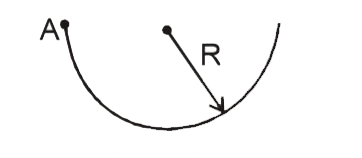Surface mass density of disc of mass m and radius R is Kr2. Then its moment of inertia w.r.t. axis of rotation passing through center and perpendicular to the plane of disc is :
1=32nR2
1=43nR2
1−25nR2
1−23nR2
The correct Answer is:D
To find the moment of inertia of a disc with a surface mass density given by σ=Kr2, we can follow these steps:
Step 1: Define the mass of a ring
Consider a thin ring of radius r and thickness dr on the disc. The area of this ring is given by:
dA=2πrdr
The surface mass density is given as σ=Kr2. Therefore, the mass dm of the ring can be expressed as:
dm=σdA=Kr2⋅2πrdr=2πKr3dr
Step 2: Calculate the moment of inertia of the ring
The moment of inertia dI of the ring about the axis perpendicular to the plane of the disc and passing through its center is given by:
dI=r2dm=r2⋅(2πKr3dr)=2πKr5dr
Step 3: Integrate to find the total moment of inertia
To find the total moment of inertia I of the disc, we need to integrate dI from r=0 to r=R:
I=∫R0dI=∫R02πKr5dr
Calculating the integral:
I=2πK∫R0r5dr=2πK(r66)R0=2πK⋅R66=2πKR66=πKR63
Step 4: Relate K to the total mass m
The total mass m of the disc can be found by integrating the mass of the entire disc:
m=∫R0dm=∫R02πKr3dr=2πK(r44)R0=2πK⋅R44=πKR42
From this, we can express K in terms of m:
K=2mπR4
Step 5: Substitute K back into the moment of inertia equation
Substituting K into the moment of inertia equation:
I=πKR63=π(2mπR4)R63=2mR63R4=2mR23
Final Answer
Thus, the moment of inertia of the disc with respect to the axis of rotation passing through the center and perpendicular to the plane of the disc is:
I=23mR2
Consider a thin ring of radius r and thickness dr on the disc. The area of this ring is given by:
dA=2πrdr
The surface mass density is given as σ=Kr2. Therefore, the mass dm of the ring can be expressed as:
dm=σdA=Kr2⋅2πrdr=2πKr3dr
The moment of inertia dI of the ring about the axis perpendicular to the plane of the disc and passing through its center is given by:
dI=r2dm=r2⋅(2πKr3dr)=2πKr5dr
To find the total moment of inertia I of the disc, we need to integrate dI from r=0 to r=R:
I=∫R0dI=∫R02πKr5dr
Calculating the integral:
I=2πK∫R0r5dr=2πK(r66)R0=2πK⋅R66=2πKR66=πKR63
The total mass m of the disc can be found by integrating the mass of the entire disc:
m=∫R0dm=∫R02πKr3dr=2πK(r44)R0=2πK⋅R44=πKR42
From this, we can express K in terms of m:
K=2mπR4
Substituting K into the moment of inertia equation:
I=πKR63=π(2mπR4)R63=2mR63R4=2mR23
Thus, the moment of inertia of the disc with respect to the axis of rotation passing through the center and perpendicular to the plane of the disc is:
I=23mR2
Topper's Solved these Questions
Similar Questions
The moment of inertia of a copper disc, rotating about an axis passing through its centre and perpendicular to its plane
View SolutionA disc of mass m and radius R has a concentric hole of radius r. Its moment of inertia about an axis through its center and perpendicular to its plane is
View SolutionThe mass of a disc is 700 gm and its radius of gyration is 20 cm. What is its moment of inertia if it rotates about an axis passing through its centre and perpendicular to the face of the disc?
View SolutionMoment of inertia of a ring of mass M and radius R about an axis passing through the centre and perpendicular to the plane is
View SolutionFour particles each of mass M are lying symmetrically on the rim of a disc of mass 6 M and radius R. Moment of inertia of this system about an axis passing through one of the particles and prependicular to plane of disc is
View SolutionFrom a circular disc of mass M and radius R, a part of 60∘ is removed. The M.I. of the remaining portion of disc about an axis passing through the center and perpendicular to plane of disc is

View SolutionA disc of radius R has a concentric hole of radius R /2 and its mass is M. Its moment of inertia about an axis through its centre and perpendicular to its plane, is
View SolutionA uniform rod of mass m is bent into the form of a semicircle of radius R. The moment of inertia of the rod about an axis passing through A and perpendicular to the plane of the paper is

View SolutionA uniform rod of mass m is bent into the form of a semicircle of radius R. The moment of inertia of the rod about an axis passing through A and perpendicular to the plane of the paper is

View SolutionTwo discs have same mass and thickness. Their materials are of densities d1andd2. The ratio of their moments of inertia about an axis passing through the centre and perpendicular to the plane is
View Solution
